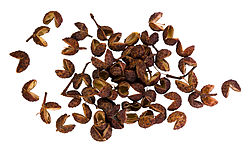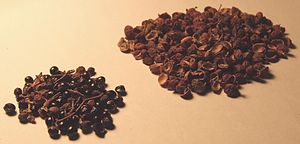Sichuan pepper

Sichuan pepper (or Szechuan pepper) is a plant fruit which is used as a spice. The outer pods of some species in the genus Zanthoxylum are used to make the spice. Many people in Asia grow them for the spice. Although the plants are called peppers, they are not related to either black pepper or Chili pepper.
Sichuan pepper is named after Sichuan, China, because it is widely used in food there. It is also used in Tibetan, Bhutani, and Japanese food cultures, among others.
Uses in food[change | change source]


Sichuan pepper has a unique aroma and taste. This taste is quite different from that of black or white pepper or chile pepper. It tastes a little like lemon. It also creates a special feeling in the mouth, a kind of numbness.
Recipes say that sichuan pepper should be slightly toasted, then crushed, before it is added to food. Only the hull (outer shells) are used in cooking; the seeds are ignored or thrown away. In general, Sichuan pepper is added at the last moment. Star anise and ginger are often used with it.
Sichuan pepper is often featured in spicy Sichuan food. It goes with fish, duck, and chicken dishes, as well as with fried eggplant. It has an alkaline pH and a numbing effect on the lips when eaten in larger doses. Ma la (Chinese: 麻辣; pinyin: málà; literally "numb and hot"), a flavour common in Sichuan cooking, is a combination of Sichuan pepper and chili pepper.
It is also available as an oil (marketed as either "Sichuan pepper oil" or "Hwajiaw oil"). In this form it is best used in stir fry noodle dishes without hot spices. The preferred recipe includes ginger oil and brown sugar to be cooked with a base of noodles and vegetables, with rice vinegar and Sichuan pepper oil to be added after cooking.
Hua jiao yan is a mixture of salt and Sichuan pepper, roasted and browned in a wok and served as a condiment to accompany chicken, duck and pork dishes. The peppercorns can also be lightly fried in order to make a spicy oil with various uses.
Sichuan pepper is one of the few spices which are important for Tibetan and Bhutanese cookery of the Himalayas. This is because few spices can be grown there. One Himalayan specialty is the momo, a dumpling stuffed with vegetables, cottage cheese or minced yak meat, beef or pork and flavoured with Sichuan pepper, garlic, ginger and onion. The noodles are steamed and served dry, together with a fiery sauce. Tibetans believe it can sanitize meat that may not be so fresh. In reality it may only serve to mask foul flavors.
In Japan the dried and powdered leaves of Zanthoxylum sansho are used to make noodle dishes and soups mildly hot and fragrant. The whole leaves, kinome, are used to flavour vegetables, especially bamboo shoots, and to decorate soups. The buds, seeds, flowers, and hulls are also used.
In Korean food, two species are used: Z. piperitum and Z. schinifolium.[1]
Import ban now lifted[change | change source]
From 1968 to 2005, the United States Food and Drug Administration banned the importation of Sichuan peppercorns because they can carry a plant disease called citrus canker (since the tree is in the same family, Rutaceae, as the genus Citrus). This bacterial disease, which is very difficult to control, might harm the foliage and fruit of citrus crops in the U.S. Citrus canker does not harm or affect humans. The import ban was only loosely enforced until 2002.[2] In 2005, the USDA and FDA lifted the ban, as long as the peppercorns are heated to around 70 degrees Celsius (160 degrees Fahrenheit) to kill the canker bacteria before importation. Later, the USDA decided that the heating was not required.
References[change | change source]
Other websites[change | change source]
- Gernot Katzer's spice pages (full of information)
- Recipes
- Sichuan Bang Bang Chicken Archived 2007-02-17 at the Wayback Machine
- Sichuan Crispy Beef (Dry-fried Beef, Gan Bian Niu Rou Si) Archived 2007-01-02 at the Wayback Machine
- Chengdu Chicken Stir-fry Archived 2007-03-02 at the Wayback Machine
- How to Make Five-spice Powder Archived 2006-12-20 at the Wayback Machine
-->
